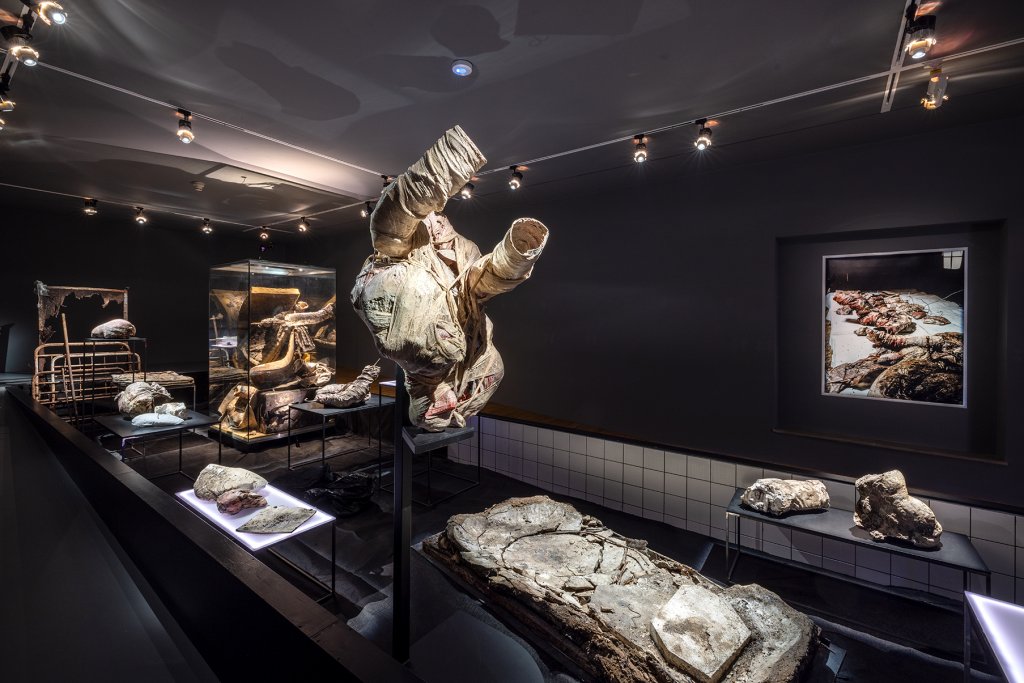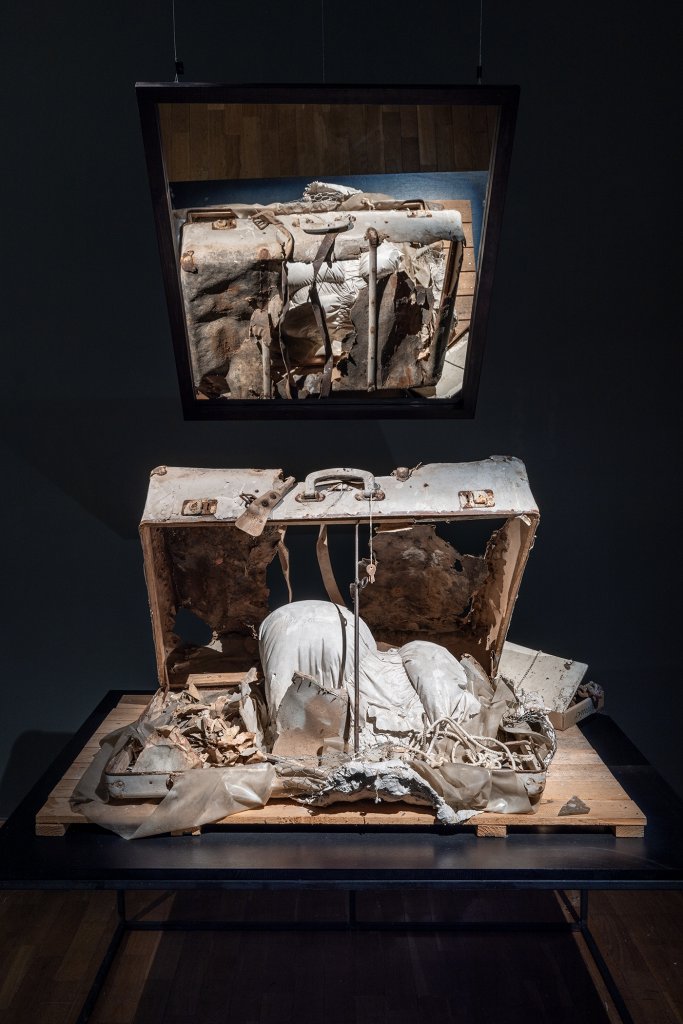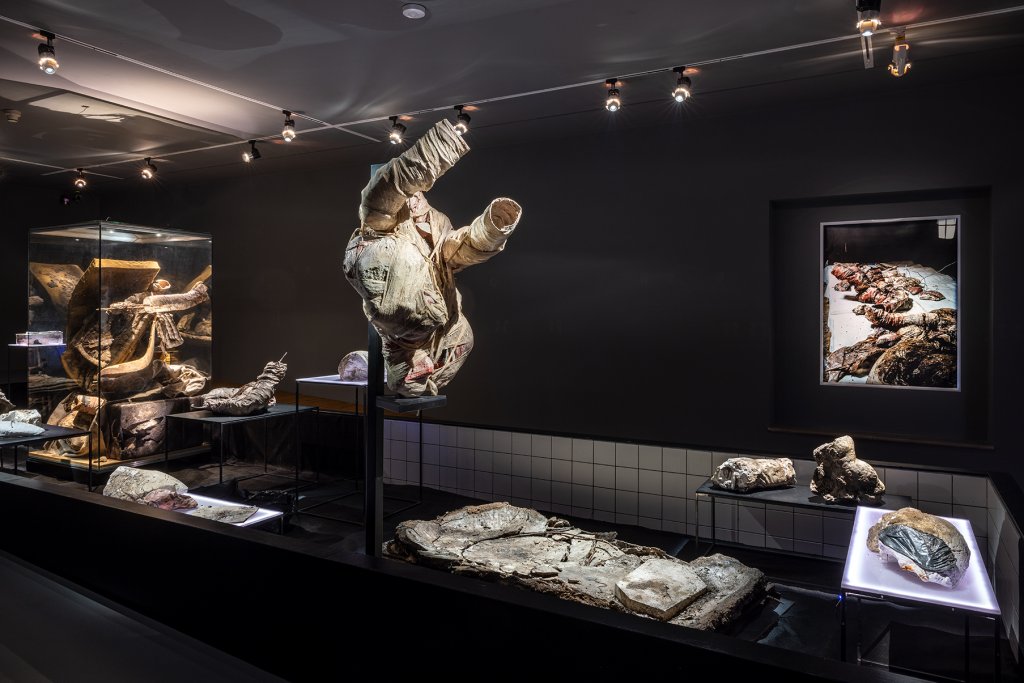ELEVATION

The exhibition reconstructs the iconic environment of Zdeněk Beran from the beginning of the normalisation period, whose later life is in many ways legendary – it includes the phases of his burial (1997) and subsequent exhumation (2011), entry into the collections of the National Gallery Prague and the Museum of Art Olomouc, respectively. The last phase, called Elevation, evokes its possible “resurrection” – as an exceptional work of art, but also as an object in the collections of a state institution. The project is prepared in cooperation with NGP. It is also part of the project Volume of the Soul / Algorithm of the Sculpture.
The environment Rehabilitation Department of Dr. Dr. was created at the very beginning of the normalization period in the basement of a house in the yard of Šaldova Street No. 8, Prague-Karlín, where Zdeněk Beran had his studio at that time. Enclosed in this space, it was subject to unstoppable devastation, with the only authentic witness – art historian Jan Kříž – reflecting on the reality of its existence in the Czech and globally. He assessed Beran’s invention as “fateful”, deeply existential and topical.
In 1992, the environment became part of the famous Pile, an installation by which the group of the Laggards – including, alongside Beran, Bedřich Dlouhý, Hugo Demartini and Pavel Nešleha – participated in an exhibition entitled Situation, accompanying the congress of the international association of art critics AICA. She commented on the predatory emergence of postmodernism in the early phase of the transformation period. However, Beran had been dealing with the problem of reinstallation since 1989 – this is evidenced by a rich collection of drawings and models, now preserved mainly in photographic documentation. He took advantage of the exhibition for a radical solution – he transported the remains of the environment to Jakub Kaše’s homestead in Lemberk, where he “de-installed” them over the next two years. The first stage of the “burial” process is still known today as the “attempt to save”, and the second as the “attempt to glaze”. The environment was supposed to be accessible to the public in this form, but after the glass was legally broken, it was buried. The fourth phase, exhumation, occurred shortly before the turn of the millennium – summoned by a unique journalistic contribution by Bedřich Dlouhý and the real activity of the then director of the National Gallery in Prague, Milan Knížák. In the form of a torso, the environment became part of the permanent exhibition of the gallery, in whose collections it is still in existence today. However, a part of it, one of the torsos and the suitcase known as Narcissus, escaped burial – and later became part of the collections of the Olomouc Museum of Art, as did the author’s photographic documentation.
The exhibition reconstructs the iconic environment of Zdeněk Beran from the beginning of the normalisation period, whose later life is in many ways legendary – it includes the phases of his burial (1997) and subsequent exhumation (2011), entry into the collections of the National Gallery Prague and the Museum of Art Olomouc, respectively. The last phase, called Elevation, evokes its possible “resurrection” – as an exceptional work of art, but also as an object in the collections of a state institution. The project is prepared in cooperation with NGP. It is also part of the project Volume of the Soul / Algorithm of the Sculpture.
The environment Rehabilitation Department of Dr. Dr. was created at the very beginning of the normalization period in the basement of a house in the yard of Šaldova Street No. 8, Prague-Karlín, where Zdeněk Beran had his studio at that time. Enclosed in this space, it was subject to unstoppable devastation, with the only authentic witness – art historian Jan Kříž – reflecting on the reality of its existence in the Czech and globally. He assessed Beran’s invention as “fateful”, deeply existential and topical.
In 1992, the environment became part of the famous Pile, an installation by which the group of the Laggards – including, alongside Beran, Bedřich Dlouhý, Hugo Demartini and Pavel Nešleha – participated in an exhibition entitled Situation, accompanying the congress of the international association of art critics AICA. She commented on the predatory emergence of postmodernism in the early phase of the transformation period. However, Beran had been dealing with the problem of reinstallation since 1989 – this is evidenced by a rich collection of drawings and models, now preserved mainly in photographic documentation. He took advantage of the exhibition for a radical solution – he transported the remains of the environment to Jakub Kaše’s homestead in Lemberk, where he “de-installed” them over the next two years. The first stage of the “burial” process is still known today as the “attempt to save”, and the second as the “attempt to glaze”. The environment was supposed to be accessible to the public in this form, but after the glass was legally broken, it was buried. The fourth phase, exhumation, occurred shortly before the turn of the millennium – summoned by a unique journalistic contribution by Bedřich Dlouhý and the real activity of the then director of the National Gallery in Prague, Milan Knížák. In the form of a torso, the environment became part of the permanent exhibition of the gallery, in whose collections it is still in existence today. However, a part of it, one of the torsos and the suitcase known as Narcissus, escaped burial – and later became part of the collections of the Olomouc Museum of Art, as did the author’s photographic documentation.
The exhibition, prepared by the two institutions in collaboration and accompanied by a rich series of lectures, discussions and animations, offers an opportunity to examine the durability of the environment in both a material and conceptual sense. Is its existential subtext still a valid appeal? Does it have the necessary intensity despite the torsional state of the work? How can it be worked within the context of a collection or exhibition? It is taking place at the time of the ten-year anniversary of the death of the artist, whose work during the totalitarian period and later post-revolutionary activity has not yet been properly evaluated. It is a logical bridge between the short-term exhibition presenting the sculpture collections of the Olomouc Museum of Art, Volume of the Soul, and the existing permanent exhibition of Central European art of the 20th and 21st centuries, Century of Relativity. It is accompanied by a narrative pictorial publication published in cooperation with Kant Publishing House. The reinstallation includes a model of the environment, the realisation of which was carried out by graduates of the Studio of Classical Painting Techniques, which Zdeněk Beran headed at the Academy of Fine Arts in Prague between 1990 and 2012. CEAD.space includes a collection of photographic documentation and period film footage.
CURATOR: Barbora Kundračíková, curator.
ARCHITECTURAL DESIGN: Barbora Bělunková
INSTALLATION: Michal Soukup, Vlastimil Sedláček, Filip Šindelář, Daniel Opletal
MODEL: Jan Gemrot, Adam Pokorný, Zdeněk Trs, Jan Uldrych
RESTORATION/ CONSERVATION: Anna Píšt’ková, Toby Pospíšilů, Dunja Stevanovič (NGP)
LIGHTING DESIGN: Pavla Beranová
GRAPHIC DESIGN: Beata Rakowská, Vladimír Vaca
EDUCATION: David Hrbek, Denisa Tessenyi
PR: Lukáš Horák, Tomáš Kasal












